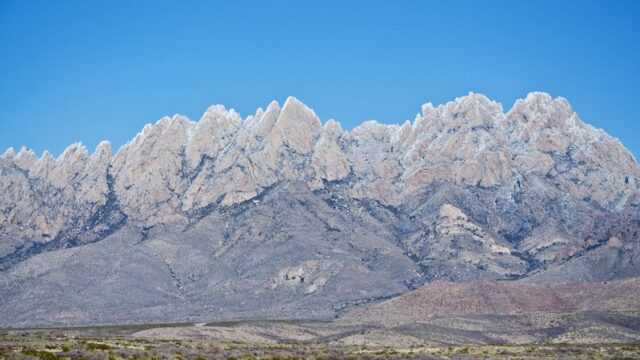Snow dusts the Organ Mountains, the remnants of an early January storm. (Danielle Prokop / Source New Mexico)
The Organ Mountains-Desert Peaks National Monument in Las Cruces is one of six national monuments Interior Department officials have identified to lose federal protections , two sources told the Washington Post in a story published Thursday.
Those federal protections prevent private companies from exploiting the monuments for minerals, oil and gas or other commodities. In addition to the monument in Southern New Mexico, the Post names ones in Utah, Arizona and California, including Baaj Nwaavjo I’tah Kukveni-Ancestral Footprints of the Grand Canyon, Ironwood Forest, Chuckwalla, Bears Ears and Grand Staircase-Escalante, on the list.
Being added to the list means Interior Department officials are reviewing geological maps to analyze the potential for mining and oil production and to assess whether to revise their boundaries, one person told the Washington Post, which provided the person anonymity to discuss decisions that had not yet been made.
Members of the state’s congressional delegation also named Organ Mountains Desert Peaks as one of three national monuments in the state — along with Rio Grande del Norte and Kasha-Katuwe Tent Rocks — potentially on the chopping block in a letter earlier this week to Interior Secretary Doug Burgum, which urged him to maintain protections.Patrick Nolan, executive director of the Friends of Desert Mountains-Organ Peaks organization, told Source New Mexico that the Thursday report represents the clearest sign yet that the “extremely popular” monument could lose its protections.
“These rumors have been percolating for a few months, and I think this is the most tangible, real thing that we have seen,” he said in a phone interview. “Right now, I have to assume that it’s real.”
Heinrich, in a post on social media, criticized the Interior Department for the prospect of selling off public lands to the highest bidder.
“Stripping Organ Mountains-Desert Peaks of its protections would be a reckless abuse of power and a slap in the face to countless New Mexicans. We have a moral responsibility to future generations that supersedes any ultra wealthy executive’s desire to line their pockets,” he wrote.
The report coincides with a leak of a draft strategy document at Interior first reported on by news organization Public Domain. The strategy document, which Source NM also obtained , lays out the messaging and objectives the department intends to use as it explores things like “releas[ing] federal holdings to allow state and local communities to reduce costs” and “increas[ing] revenues from grazing, timber, critical minerals, gravel and other non-energy resources.”
Nolan noted that Organ Mountains-Desert Peaks is a relatively new national monument, first granted federal protection in 2014 under President Barack Obama. During President Donald Trump’s first term, his administration reviewed it and other Southwest monuments to potentially strip their federal protections.
In that period, Nolan said, no mining or other private interest clamored to extract resources from the land now protected.
“It makes it more confusing,” he said. “Because there is no known, at least to me and the general public, presence of these materials. So it really calls into question, what is the real intention behind these reviews and boundary redrawing?”
Nolan’s best guess? “They don’t like protected public lands,” he said.
In the decade since becoming a national monument, Organ Mountains-Desert Peaks has become wildly popular and a major economic driver in the region, Nolan said. Businesses like Organ Mountain Outfitters have popped up, and it’s become a national destination for bicycle backpacking, he said.
According to a study commission by the Las Cruces Green Chamber published last year, the designation of Organ Mountains-Desert Peaks has resulted in a $234 million economic impact over the last decade. Visitation to the area increased from 183,900 in 2012, which was before it became a national monument, to 612,781 in 2022, according to the report.
The news of Organ Mountains-Desert Peaks moving closer to losing its protected status drew rebukes across New Mexico’s conservation interest groups. New Mexico Wild is one of them.
“That this president would contemplate this action with zero consultation from our communities is exactly the kind of DC driven, top down, intrusive and unwanted government interference that he claimed as a candidate to be against,” Executive Director Mark Allison said in a statement.




